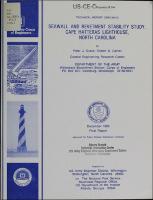Please use this identifier to cite or link to this item:
https://hdl.handle.net/11681/12567| Title: | Seawall and revetment stability study, Cape Hatteras Lighthouse, North Carolina |
| Authors: | United States. National Park Service. Southeast Regional Office United States. Army. Corps of Engineers. Wilmington District Grace, Peter J. Carver, Robert D. |
| Keywords: | Armor stone Seawalls Cape Hatteras, North Carolina Stapods Hydraulic models Water waves Revetments Ocean waves Wave pressures Models |
| Publisher: | Coastal Engineering Research Center (U.S.) Engineer Research and Development Center (U.S.) |
| Series/Report no.: | Technical report (U.S. Army Engineer Waterways Experiment Station) ; CERC-85-12. |
| Description: | Technical Report Abstract: A two-dimensional model investigation was conducted to provide input for the design optimization of a seawall-revetment shore protection system proposed for long-term protection of the lighthouse at Cape Hatteras, North Carolina. The specific purposes of this investigation were as follows: (a.) Tests were performed to determine the most severe wave conditions relative to the stability of the seawall and stone revetment within the limits of still-water levels and wave periods that could be expected to occur in the prototype area. These tests led to the development of a storm-surge hydrograph to which the seawall-revetment sections were subjected. The hydrograph included still-water levels of +2.6, +4.3, +6.9, and +8.6 ft mean sea level and wave periods of 6, 8, 10, 12, and 14 sec. The most severe breaking wave heights ranged from 9.0 to 17.0 ft. (b.) Several stone revetment sections were tested under the worst breaking wave conditions to optimize the geometry and stone sizes. Results indicated that the revetment plan characterized by 6.3-ton primary armor stone would be an adequate design. (c.) Pressure tests were conducted to determine the distribution of wave forces on the seawall so that the seawall could be designed to withstand the resultant forces and ensure stability against overturning and sliding. The seawall geometries tested included a vertical wall and two recurved walls. The two recurved seawalls were very similar in design; however, one included a slightly different crown geometry designed to reduce overtopping. Results indicated that the modified recurved seawall (Plan R4S3) was the most suitable design tested in terms of minimizing pressures on the face of the wall and reducing runup and overtopping. NOTE: This file is large. Allow your browser several minutes to download the file. |
| Rights: | Approved for public release; distribution is unlimited. |
| URI: | http://hdl.handle.net/11681/12567 |
| Appears in Collections: | Technical Report |
Files in This Item:
| File | Description | Size | Format | |
|---|---|---|---|---|
| TR-CERC-85-12.pdf | 34.29 MB | Adobe PDF |  View/Open |